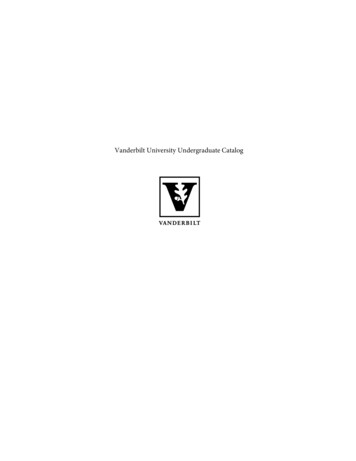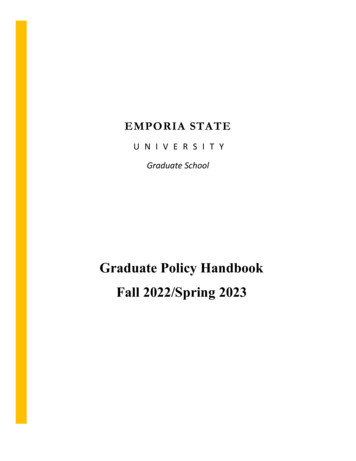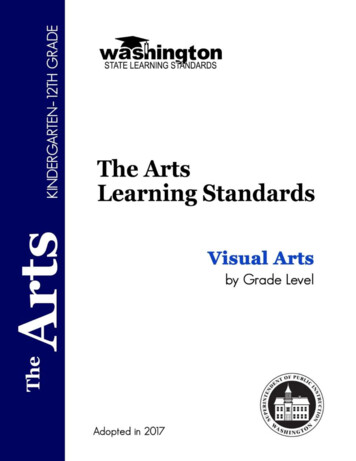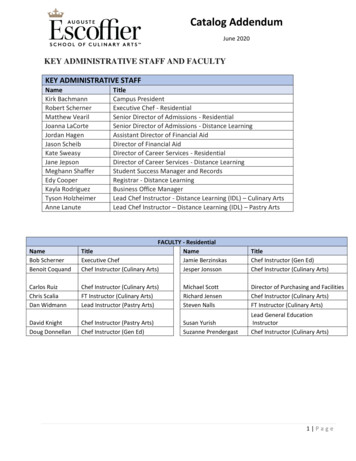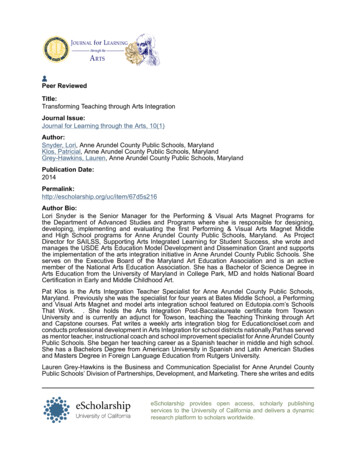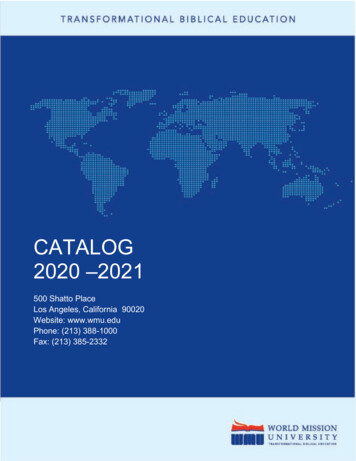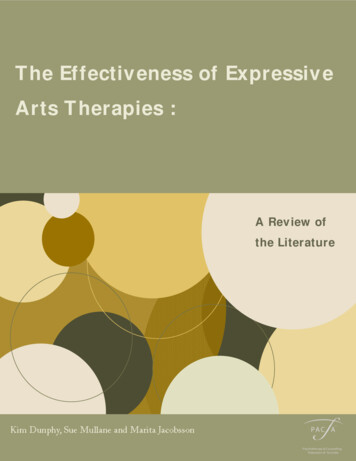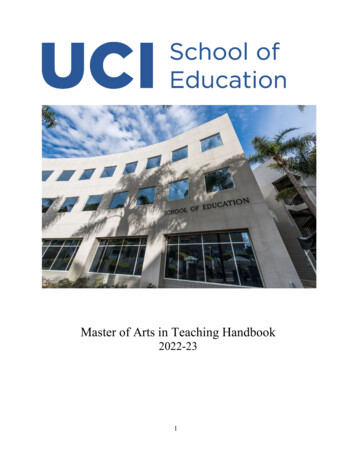
Transcription
Master of Arts in Teaching Handbook2022-231
Student HandbookMaster of Arts in TeachingProgramTABLE OF CONTENTSA Note from the Director . 3Purpose and Use of Student Handbook . 4Program Values and Core Commitments . 5Vision Statement for UCI Educator and Leadership Preparation Programs .7Program Features & Requirements .8Student Representation, Voice, and Resolution Policies .15Campus Resources . 16Ethical and Conduct Expectations .17Responsibilities of Credential Candidates. 19Social Media Guidelines . 21Academic Integrity . 23Grading Policy.24Leave of Absence . 24Substitute Teaching . 24Advancement to Student Teaching .25Preliminary Teaching Credential. .25Clear Credential . 25Final Steps for Graduate Students Earning the MAT Degree . 25Professional Learning Outcomes . 27Appendix . 282
A Note from the DirectorEnthusiastically, I join Dean Frances Contreras, our faculty, and our staff in welcoming you to theUCI School of Education (SOE) Master of Arts in Teaching Program. We are confident that you willgrowand contribute in equal proportion as a member of this vibrant learning community.The process of becoming a teacher is different from what many outside the profession imagine it tobe. Far beyond learning a body of knowledge and mastering a set of skills, it entails an activeinvestment in understanding and applying knowledge of human development, learning theory, andpedagogy. Most important is the application of that knowledge to classroom practice anddemonstration of beginning competency in all areas related to the profession. No one becomes ateacher in just one year; in fact, excellent teachers will tell you they never stop learning from theirwork.We acknowledge this cornerstone of continuous professional improvement with our programslogan: Learning to Teach, Teaching to Learn. As you shape your identity as a teacher, you willparticipate in multiple professional communities here at UCI and in the schools. We have seen overthe years that those who engage most completely in their course work and school-basedexperiences enjoy success in the program and go on to become teacher leaders.This is the beginning of a lifetime membership. The UCI experience will be a marker in yourprofessional trajectory. We hear from our graduates for years after the program, and we hope toform a lasting relationship with you as well.The purpose of this handbook is explained on the next page. While we always welcome yourquestions, we encourage you to use the handbook as a resource when we’re not available.Sincerely,Virginia PanishVirginia Panish, Ph.D.Director of Teacher Education3
Purpose and Use of Student HandbookThe Student Handbook is designed to assist you into and during the program. It containsimportant information to guide you as you progress through the program. Included are relevantschool policies and procedures. Additional program information can be found in the Single andMultiple Subject Handbooks provided by your program coordinatorScan the handbook and familiarize yourself with its content. Whenever you have questionsabout program policies, procedures and/or requirements, please contact the credential counselor,program coordinator, or program director to clarify matters for you.Standards for teacher preparation programs can be found on the California Commissionon Teacher Credentialing (CTC) website. Please be aware that University of California programsfor professions that require licensure or certification, such as the UCI MAT program, are intendedto prepare the student for California licensure and certification requirements (UCOP DisclosureStatement). While our program design and curriculum are based upon CTC standards, we believethat the UCI experience exceeds these standards and will help you develop the characteristics thatwill make you exceptionally well prepared upon completion of theprogram.Other sources of official university information which may be useful include the currentregistration information found on the Registrar's Office website and campus-based studentresource information such as the Financial Aid Office. This handbook is intended to be used as aguide and does not include all of the information related to graduate student processes andresources. For additional information, visit the Graduate Division Website or the UCI Cataloguewhich are official sources for university policies and procedures.4
Program Values and Core CommitmentsThe University of California BrandUCI joins teacher preparation programs at our sister campuses to espouse the following values inour program:We believe that: Schools should be equitable and engaging places of learning for every child. Teachers are critical agents of educational innovation and change. Teaching is complex; programs must therefore address the multiple dimensions ofschooling. Effective teaching requires collaborative, inquiry-oriented practices. Preparing new teachers to transform educational experiences for children calls forpurposeful preparation sustained over time. Sustained, authentic partnerships with K-12 schools are essential for high quality teacherpreparation.With the above beliefs in mind, the UCI Master of Arts in Teaching Program is thoughtfully designedto address five core commitments:Equity: We are committed to preparing candidates who understand the challenges that studentsfrom traditionally under-served populations experience in school, who develop agency toadvocate for underserved student populations and who have a commitment to addressinginequities that reside in the educational system. We draw on research on equity in schooling to5
inform the design of courses and learning experiences to support candidates in developingattention to issues of equity in teaching.Understanding Learners & Learning: We are committed to preparing candidates who focus onlearners and learning. We prepare candidates to understand who the learners are in theirclassrooms and how to design instruction that draws on the competencies and knowledge thatstudents bring to bear on their learning. We also provide candidates with experiences to studytheories of learning and development, while also observing and reflecting on those theories incontext. Candidates use these experiences to guide instructional planning and decision-making.Teaching and Learning in the Content Areas: We are committed to preparing candidates toteach in the content areas and to developing their content knowledge for teaching andpedagogical practices unique to the discipline. Using practice-based approaches to teacherpreparation, candidates learn high leverage practices for teaching in the content areas.Learning from Teaching: We are committed to preparing candidates to learn in and from theirpractice. Teacher candidates cannot learn all they need to learn in teacher preparation but theycan learn how to systematically inquire about teaching and learning, collect data to provideinsight on instruction, and use what they learn through professional collaboration to improvetheir practice.Leadership: We are committed to preparing candidates who will become leaders in their school.We use innovative approaches to teacher education to cultivate their practices for leading teacherlearning once they become teachers. Teaching and Learning in the Content Areas: We arecommitted to preparing candidates to teach in the content areas and to developing their contentknowledge for teaching and pedagogical practices unique to the discipline. Using practice-basedapproaches to teacher preparation, candidates learn high leverage practices for teaching in thecontent areas.6
Vision Statement for UCI Educator and Leadership Preparation ProgramsThe UCI School of Education’s vision is to improve educational opportunities in the university,community and public schools. We are dedicated to producing innovative, cutting-edge researchand cultivating the next generation of educators and leaders who will contribute to atransformational shift in education, ensuring that all students are adequately prepared assuccessful and productive participants in a democratic society. To this end, the UCI educatorcertification programs are committed to preparing candidates who: Implement research-based practices aligned with the needs of California’s diverse learnersDemonstrate critical agency, advocacy and leadership to improve the educationalexperiences of underserved students in California public schoolsReflect critically and consistently about student learning, teaching practice and school-widesystemsStrive for equity of educational opportunity and culturally responsive practices to promoteeach student’s academic success and well-beingChallenge deficit narratives about diverse students’ success at schoolCollaborate with school and local communities to leverage and enhance resources, assetsand knowledge.7
MAT Program Features and RequirementsSchedule and Time CommitmentThrough UCI’s 14-month program, you will earn both a master’s degree in teaching and a teachingcredential. This full-time program includes both course work and fieldwork. In addition to the 600hours spent at school sites, you will be grading papers, planning lessons, attending UCI courses andcompleting assignments. Most candidates have found that it is almost impossible to hold a part- timejob during the program. Candidates are not able to take time off for vacations or other commitments,except of course, for illness or emergency.Attendance is required beginning in mid-June for the Master of Arts in Teaching (MAT) Orientation.Summer Session courses begin in the third week of June and continue through early September.Fieldwork in public schools begins in mid-August/early September and UCI fall classes begin inSeptember or early October. Student teaching begins at the end of fall quarter and continuesthroughout spring quarter, ending in mid to late June. Course work continues during studentteaching. You are committed to full-time attendance in the MAT program from orientation in midJune through the end of Summer Session I the following year.Calendar for Multiple Subject Pathway and Multiple Subject with BilingualAuthorization PathwayTime FrameCourses andUnitsFieldworkRequirementsSummer 1Summer 1Session 1Session 25 weeks:5 weeks:10 Weeks:10 weeks:10 weeks:5 weeks:3 courses4 courses7 courses5 courses4 courses2 coursesContinue at schoolsite (minimum 16hours per week)*December fulltime co-teachingBegin studentteaching (4 fullschool days eachweek)Late June-LateJuly(10 units)Observations in anelementaryscience programEarly AugustEarly September(12 units)Begin fieldwork atschool site(minimum 16hours per week)Fall QuarterWinter QuarterSpring QuarterSummer 2Session 1Late SeptemberMid Dec.(24 units)8Early Jan-March(16 units)Early April MidJune(22 units)Begin new studentteachingplacement (5 fullschool days perweek)Late June-LateJuly(6 units)None
Single Subject CalendarTime FrameCoursesandUnitsFieldworkRequirementsSummer 1Summer 1Session 1Session 25 weeks:Late June-LateJuly3 courses(10 units)5 weeks:Early AugustEarly September3 courses(8 units)Conductobservations orinterview(s)Begin fieldwork atschool site(minimum 10hours per week)Fall QuarterWinter QuarterSpring QuarterSummer 2Session 110 Weeks:Late SeptemberMid Dec.6 courses(22 units)Continuefieldwork atschool site(minimum 10hours per week)*December fulltime co-teaching10 weeks:Early Jan-March4 courses(16 units)Begin studentteaching (5 fullschool days eachweek)10 weeks:Early April MidJune4 courses(20 units)Continue studentteachingplacement (5 fullschool days perweek)5 weeks:Late June-LateJuly2 courses(8 units)NonePublic School PlacementsA sustained school-based placement occurs in conjunction with coursework during the three UCIMAT with credential programs (multiple subject, multiple subject with bilingual authorization andsingle subject) to provide a context for guided apprenticeship into practice, application of theory, andcompletion of course assignments. Our co-teaching model of teacher preparation provides ourcandidates with the opportunity to collaborate with an experienced mentor teacher while graduallytaking on more responsibility in the classroom. Coordinators work with district and schooladministrators to select qualified mentor teachers.Mentor teachers for the MAT Single Subject and Multiple Subject programs must have 3 or more years of full-time teaching experience the appropriate California teaching credential to support the assigned student teacher demonstrated exemplary teaching in or across disciplines and grade levels expertise in developing and implementing California State Standards and frameworks experience working collaboratively with other teachers skillfully coached pre-service teachers and/or beginning teachers in the past (and/or hasexperience mentoring adults) demonstrated a positive impact on student learning been identified by administrators as effective teachersMentor teachers for the Bilingual program must have 3 or more years of full-time teaching experience in a dual immersion classroom Appropriate California teaching credential and authorizations to support the assignedstudent teacher Demonstrated exemplary teaching in both languages in or across disciplines and grade levels Expertise in developing and implementing California State Standards and frameworks Experience working collaboratively with other teachers Experience coaching pre-service bilingual teachers and/or beginning bilingual teachers inthe past (and/or has experience mentoring adults) Has demonstrated a positive impact on student learning in a dual immersion classroom Identified by administrators as an effective bilingual teacherMultiple Subject Placements and Multiple Subject Bilingual Placements (Spanish)Multiple Subject candidates in both the English and Bilingual programs complete two placementsduring the MAT Program: one in grades K-2, another in 3-6.* Either one can be first. The firstplacementbegins with the public school calendar and continues throughout fall quarter. Multiple9
Subject candidates are placed with mentor teachers in diverse K-6 public school classrooms to becomefamiliar with the processes of instructional planning, student engagement, and formative andsummative assessment strategies with native speakers and English learners. Candidates in theBilingual program are placed in dual immersion classrooms for both placements. All candidates arerequired to be in fieldwork two days per week during most of fall quarter, transitioning to full-time coteaching during the last 2-3 weeks of the quarter. University supervisors oversee the experience ofcandidates in the fall through 4 observations and 4 post observation conferences, including a meetingto review each candidate’s progress on the Teacher Performance Expectations.In winter, candidates move to their new placement and gradually assume the lead role in the coteaching relationship, with the goal of achieving full autonomy under the guidance of the mentorteacher. With support from a university field supervisor and the mentor teacher, candidates havemultiple and systematic opportunities to observe, develop, deliver, and reflect on instruction.University supervisors will observe candidates 4 times winter quarter and engage candidates in a postobservation conference and provide written feedback and an opportunity to discuss plans for nextsteps.By spring quarter, candidates have assumed the lead role in planning and instruction, taking onresponsibility for all subject areas. Once again, university supervisors observe each candidate 4 timesand provide feedback on progress. The final supervisor observation includes a conference with thementor teacher to determine each candidate’s Individual Induction Development Plan.*Under certain circumstances, candidates remain at the same placement for the entire year.The Single Subject PlacementSingle Subject placements are yearlong assignments comprised of fall quarter and at least 600 hoursof fieldwork, including a minimum of twenty weeks of student teaching; the middle or high schoolassignment begins and ends with the public-school calendar. The goal of fall quarter fieldwork is toincrease competence in the classroom through increased involvement in co-planning and co-teachingwith an experienced mentor. Candidates attend fieldwork 2 days per week for most of fall quarter, andtransition to 2 weeks of full-time co-teaching at the end of the quarter. Through this apprenticeship,candidates obtain sufficient comfort and experience with classroom routines, planning and delivery oflessons, and assessment of student learning to assume primary responsibility for two classes in winterand spring quarters. With support from a university field supervisor and the mentor teacher,candidates have multiple and systematic opportunities to observe, develop, deliver, and reflect oninstruction. University supervisors oversee the experience of candidates in the fall through 4observations and 4 post-observation conferences, including a meeting to review each candidate’sprogress on the Teacher Performance Expectations. In the winter and spring, supervisors conduct 8observations and engage candidates in a post-observation conferences, following up with writtenfeedback and an opportunity to discuss plans for next steps. The final supervisor observation includesa conference with the mentor teacher to determine each candidate’s Individual Induction DevelopmentPlan.In addition to planning and teaching two content-area classes, candidates will serve in an AcademicSupport Experience at their school site. With a focus on diversity and underserved studentpopulations, this opportunity allows candidates to observe and respond to students with specialneeds and non-native speakers. Although the UCI spring quarter concludes in early June, studentteaching continues through the end of the K-12 school year.10
Course of StudyCandidates are responsible for completing all courses in the course of study. The course of study atthe time a student begins the program will remain in effect, even if a break in enrollment occurs. Thecourse of study for each program is listed below:Multiple Subject Course of Study:Summer oneSession one374 (4) ChildDevelopment &LearningSummer oneSession two202 (4) Outcomes ofSchooling/StudentAssessmentFall241 (2) Children’sSense Making inScience364 (2) InstructionalDesign & EducationTech. for theElementary SchoolClassroom323A (2) Curriculum &Methods forElementary SchoolScience320 (4) TeachingPhysical & HealthEducation inElementary School230 (4) History &Culture of Schoolingin the United States347 (4) Culture,Diversity &Educational EquityTotal (10 Quarterunits)Winter301 (2) DirectedElementary FieldExperiences inDiverse Schools322A (4)Curriculum &Methods forElementary SchoolMathematics323B (2)Curriculum &Methods forElementary SchoolScience326 (4) Curriculum& Methods forElementary Reading362 (4) Curriculum& Methods forElementary EnglishLanguage Arts &English LanguageTotal (20 quarterunits)Total (12 quarterunits)304 (8) StudentTeaching in theElementary SchoolOR306 (8) SupervisedTeaching inBilingualEducation348A (2)Educational Equity& the ExceptionalLearner322B (4)Curriculum &Methods forElementary SchoolMathematics325 (2) Teachingthe Visual &Performing Arts inElementary School246 (4) TeachingInvestigation:IdentifyingDilemmas ofPracticeTotal (20 quarterunits)SpringSummer twoSession one248 (4)UnderstandingTeacher Agency359 (4) Curriculum &Methods forElementary SchoolSocial Science &Information Literacy348B (2) EducationalEquity & theExceptional Learner243 (2) The PolicyEnvironment ofTeaching304 (12) StudentTeaching in theElementary SchoolOR306 (12) SupervisedTeaching in BilingualEducation247 (4) TeachingInvestigation:Exploring theDilemmas of PracticeTotal (22 quarterunits)Total (6 quarterunits)Single Subject Course of Study:Summer oneSession two245 (2)Learning Inside& Outside ofSchool361 (4) TheAdolescentLearnerSummer oneSession two243 (2) PolicyEnvironment ofTeachingFallWinterSpring302 (2) DirectedSecondary FieldExperiences307 (8) StudentTeaching inIntermediate/HighSchool342A AppliedInstructional Strategiesin Secondary Schools(Language,Mathematics, Arts,Science, Social Science,Visual Arts, or WorldLanguages)230 (4) History& Culture of358 (2) Media &Information336-341 (4) Methodsof Teaching (Language349 (4) Theories &Methods of English307 (12) StudentTeaching inIntermediate/HighSchool342B (2) AppliedInstructionalStrategies inSecondary Schools(Language Arts,Mathematics,Science, SocialSciences, VisualArts, or WorldLanguages)348B (2)Educational Equity202 (4) OutcomesofSchooling/StudentAssessment305 (4) Learning toLearn from Teaching11Summer twoSession one248 (4)UnderstandingTeacher Agency206 (4) Design ofLearningEnvironments
Schooling in theUnited StatesLiteracy348A (2)EducationalEquity & theExceptionalLearnerTotal (10Quarter units)Total (10 quarterunits)Arts, Languages otherthan English,Mathematics, Science,Social Science, orVisual Arts) inSecondary School346 (4) Reading &Writing in the Middle& High SchoolClassroom347 (4) Culture,Diversity &Educational EquityTotal (18 quarterunits)Language Development& the ExceptionalLearner246 (4) TeachingInvestigation:Identifying Dilemmas ofPractice247 (4) TeachingInvestigation:Exploring Dilemmasof PracticeTotal (18 quarter units)Total (20 quarterunits)Total (8 quarterunits)Examinations and CompetenciesDifferent types of assessments are required by the State of California and the Commission on TeacherCredentialing prior to and throughout the program. They are listed and described below in typicalorder of occurrence.Basic Skills Competency in reading, writing, and mathematics: Candidates need to pass theCalifornia Basic Educational Skills Test (CBEST) prior to admission.Subject Matter Competency: Candidates are required to pass the appropriate California SubjectExams for Teachers (CSET) prior to the start of the program.Reading Instruction Competence RICA website, Generally completed right after the fall quarter, theReading Instruction Competency Assessment (RICA is required for all multiple subject candidates.Though the elementary reading course is much more than a test preparation course, it contributessubstantially to readiness for the exam. Candidates will be advised during the elementary readingmethods course about the recommended dates for taking the exam.United States Constitution Competency: Candidates need to verify that they have knowledgeequivalent to a college-level course in political science either through prior course work or passingan approved US Constitution exam. This is a credentialing requirement, and as such, can becompleted any time prior to applying for the credential.Life-Saving Competency: Candidates must provide a valid certificate of competence ininfant/child/adult cardiopulmonary resuscitation in order to apply for a credential. Opportunity willbe provided to take a Saturday training course in spring of each year at a nominal cost, but thecertificate can be obtained through any approved entity.Beginning Teaching Competency: All California pre-service teachers must demonstrate beginning teaching competency througha State-approved assessment in order to apply for a credential. This assessment is known asthe Teaching Performance Assessment (now called the edTPA). The program will providemultiple and systematic opportunities to develop competency prior to completing the edTPA.Students should be prepared to pay the fee associated with this test (currently 300.00). Candidates will be evaluated on the Teaching Performance Expectations throughout theprogram and be provided systematic support to meet these competencies.12
System for Evaluating Progress on Teaching Performance Expectations and on or FeedbackOversight and SupportTPE aligned assignments in methodscoursesAssignment feedback and grades (anoverall grade of B or better in eachcourse is required to remain in theprogram)12 supervisor observations-Post-observation conference toreview performance on TPEcompetencies-TPE aligned evaluation form onQualtrics-Students track TPE scores on selfassessment form- Identification of action plan forimprovementFall and Winter progress conference-Supervisors review evaluations andmeet with candidate to discussprogress on TPEs and talk about nextsteps for improvement-Instructors meet with students whoare struggling to provide support-Instructors communicate withprogram coordinators and theprogram director about students whoare struggling-Coordinators and director meet withstruggling students to providesupport. This may involve a referralto the graduate counselor or creating acontract outlining steps the candidateneeds to take to meet competencies.-Coordinators review qualitative TPEscores through Qualtrics andcommunicate regularly withsupervisors about candidate progress-Coordinators conference withcandidates struggling to makeprogress in their fieldwork andstudent teaching-Various strategies for support areemployed including:Contract with student withoutlined steps forimprovementJoint conference with mentorteacher, supervisor andcoordinatorTargeted strategies andresources to support aparticular area of needAdditional observations bysupervisors or programcoordinator13-Supervisors communicate withcoordinator if they are concernedabout a candidate’s lack of progress--Coordinators conference withcandidates struggling to makeprogress in their fieldwork andstudent teaching-Various strategies for support areemployed including:Contract with student withoutlined steps forimprovementJoint conference with mentorteacher, supervisor andcoordinator
3 mentor teacher evaluations-TPE aligned evaluation form onQualtrics-Meeting with mentor to discussprogressedTPA-Rubric-based scores providedthrough PearsonPerformance in Fieldwork/StudentTeacher Seminars (ED 301, 302, 304,306 and 307)-Course grades are directly linked toperformance in fieldwork and studentteaching. Candidates must earn a B orbetter to remain in good standing inthe program and retain theirplacements.-Program coordinators teach thesecourses during fall, winter and springquarters and reviewfieldwork/student teachingassignments and provide feedback onassignments.14Targeted strategies andresources to support aparticular area of needAdditional observations bysupervisors or programcoordinator-Coordinators review Qualtrics scoresand comments from mentor teachers-Coordinators conference withcandidates struggling to makeprogress in their fieldwork andstudent teaching-Various strategies for support areemployed including:Contract with student withoutlined steps forimprovementJoint conference with mentorteacher, supervisor andcoordinatorTargeted strategies andresources to support aparticular area of needAdditional observations bysupervisor or programcoordinator-edTPA coordinator providesseminars to support understandingexpectations and rubrics-edTPA coordinator meets withindividual students to provide support-edTPA coordinator and methodsinstructors conference withcandidates who need to remediate andresubmit to provide support-Coordinators monitor fieldwork andstudent teaching assignments tied toTPEs and program/school siteexpectations (e.g., fieldwork andstudent teaching hours).- Coordinators conference withcandidates struggling to makeprogress in their fieldwork andstudent teaching-Various strategies for support areemployed including:Contract with student withoutlined steps forimprovementJoint conference with mentorteacher, supervisor andcoordinatorTargeted strategies andresources to support aparticular area of need
Individual Induction PlanThe candidate, supervisor and mentorteacher meet to review progress onthe TPEs and discuss areas of strengthand identify areas for growth.-Induction coordinator reviewsdocument and guides new teachers increating goals.Comprehensive Exam: Candidates are requ
Through UCI's 14-month program, you will earn both a master's degree in teaching and a teaching credential. This full-time program includes both course work and fieldwork. In addition to the 600 hours spent at school sites, you will be grading papers, planning lessons, attending UCI courses and completing assignments.

